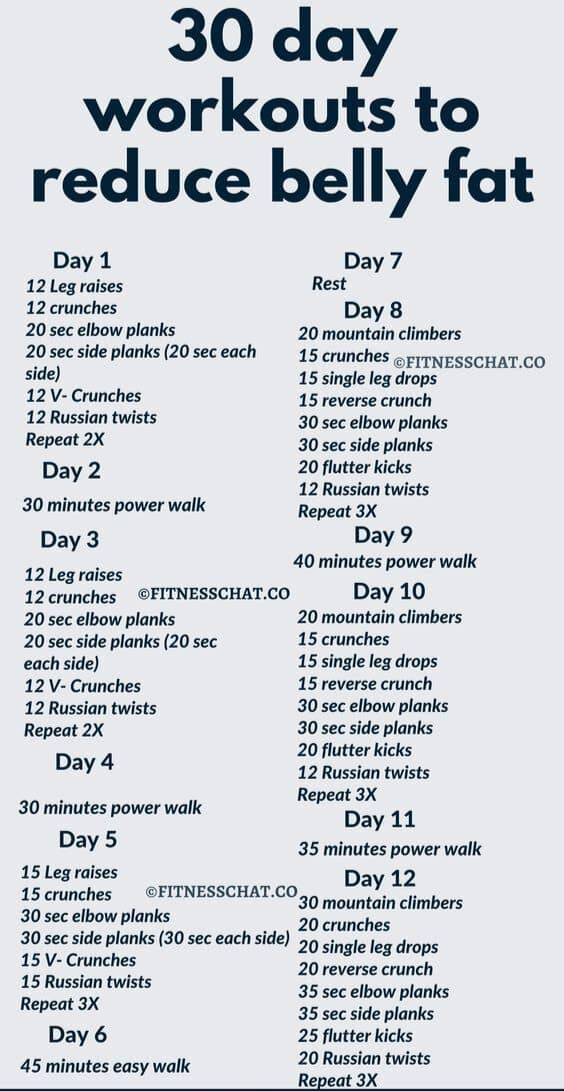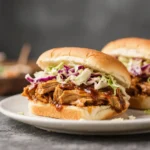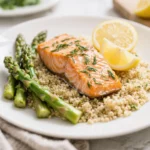30-Day Belly Fat Reduction Workout Plan: Your Comprehensive Guide to a Stronger Core and Healthier Body
Are you looking for a safe, effective, and straightforward way to work on your midsection and reduce belly fat? The following 30-day plan, inspired by the workout schedule in the image, is designed to help you strengthen your core, build endurance, and support overall fitness. Remember, true “spot reduction” of fat (focusing on a single area) is limited, and healthy fat loss usually requires a comprehensive approach that includes balanced nutrition, cardiovascular exercise, sufficient rest, and a consistent workout routine. In this article, you will find a detailed breakdown of each day’s workout, guidance on proper technique, and tips to maintain motivation throughout the 30-day journey. Let’s dive in!
Table of Contents
- Why a 30-Day Belly Fat Reduction Challenge?
- Safety First: Consult with a Professional
- Key Exercises and Their Benefits
- The 30-Day Workout Plan: Day-by-Day Breakdown
- Day 1
- Day 2
- Day 3
- Day 4
- Day 5
- Day 6
- Day 7
- Day 8
- Day 9
- Day 10
- Day 11
- Day 12
- Continuing to Days 13–30 (Progression Tips)
- Form and Technique Tips
- Lifestyle Factors: Nutrition, Sleep, and Stress Management
- Staying Motivated and Overcoming Plateaus
- Final Thoughts and Next Steps
- Frequently Asked Questions
1. Why a 30-Day Belly Fat Reduction Challenge?
A 30-day workout challenge provides a clear timeline and structured approach to achieving a fitness goal—in this case, focusing on core strength and overall fat loss. With daily guidelines to follow, you can keep yourself accountable and measure progress from start to finish. By the end of these 30 days, you may notice:
- Improved core strength and stability.
- Increased endurance and overall fitness.
- Potential reduction in abdominal fat.
- Greater motivation to maintain a healthy lifestyle.
It is important to note that while the workouts focus on the abdominal region, reducing overall body fat through a balanced diet and regular exercise is the most effective long-term strategy. That being said, a well-designed routine that incorporates both resistance training and cardiovascular activity can significantly support your fat loss and core-strengthening efforts.
2. Safety First: Consult with a Professional
Before beginning any exercise routine—particularly if you are new to fitness, have any medical conditions, or have concerns about injury—it’s always wise to consult with a healthcare or fitness professional. They can provide personalized guidance and ensure you’re physically ready to undertake this 30-day challenge. Proper form is essential, especially in core workouts, to prevent injuries and maximize results. If you experience any sharp pain or discomfort, discontinue the exercise immediately and seek medical advice.
3. Key Exercises and Their Benefits
Below are brief explanations of the exercises that will appear in this 30-day plan. Understanding why they are beneficial can help you appreciate their importance and maintain proper form:
- Leg Raises
- Target: Lower abdominals, hip flexors
- Benefit: Improves core strength and stability, especially in the lower abdomen.
- Crunches
- Target: Upper abdominals
- Benefit: Strengthens the rectus abdominis (the “six-pack” area) and improves core definition.
- Elbow Plank
- Target: Entire core (shoulders, back, abdominal muscles)
- Benefit: Builds core endurance and stability. The plank is a compound exercise that engages multiple muscle groups.
- Side Plank
- Target: Obliques, shoulders, hips
- Benefit: Focuses on the lateral abdominal muscles and improves overall core balance.
- V-Crunches (V-Ups)
- Target: Upper and lower abdominals, hip flexors
- Benefit: Challenges the entire core region and helps coordinate hip flexion with abdominal strength.
- Russian Twists
- Target: Obliques and rotational core strength
- Benefit: Helps tone the sides of the waist and improves twisting/rotational core movements.
- Mountain Climbers
- Target: Full body exercise with emphasis on the core, shoulders, and legs
- Benefit: Great cardio move that also engages the core, helping to burn calories and build endurance.
- Single Leg Drops
- Target: Lower abdominals, hip flexors
- Benefit: Strengthens the lower core region and helps build stability while protecting the lower back if done correctly.
- Reverse Crunch
- Target: Lower abdominals
- Benefit: Focuses on lifting the lower half of the body, engaging the lower abdominal region.
- Flutter Kicks
- Target: Hip flexors and lower abdominals
- Benefit: Improves endurance in the lower abs and hip flexors, often used in conditioning programs.
- Power Walk
- Target: Cardiovascular system, lower body
- Benefit: Low-impact cardio that supports fat-burning and improves heart health.
- Easy Walk
- Target: Cardiovascular system, recovery
- Benefit: Allows active recovery and gently burns calories without placing too much stress on the joints.
- Rest Day
- Benefit: Recovery is crucial for muscle repair and preventing injury.
By combining these exercises in different sequences and volumes (reps, sets, and duration), this program provides variety and progressive overload, pushing your body to adapt and grow stronger.
4. The 30-Day Workout Plan: Day-by-Day Breakdown
Below is the workout schedule as inspired by the image. Pay attention to the recommended repetitions, time durations, and how many times you should repeat each circuit. We will include tips on when to rest and how to handle progression. The core idea is to alternate more intense abdominal-focused workouts with lower-impact cardio or rest days for optimal recovery.
Day 1
- Exercises:
- 12 Leg Raises
- 12 Crunches
- 20-second Elbow Plank
- 20-second Side Planks (each side)
- 12 V-Crunches
- 12 Russian Twists
- Sets: Repeat the entire sequence 2 times
Tip: Keep your core tight during each exercise. This helps isolate your abdominal muscles and protects your lower back.
Day 2
- Workout: 30 minutes of power walking
Tip: Maintain a brisk pace. Power walking is a low-impact form of cardio that can help increase your daily calorie burn and aid in fat loss.
Day 3
- Exercises (same as Day 1):
- 12 Leg Raises
- 12 Crunches
- 20-second Elbow Plank
- 20-second Side Planks (each side)
- 12 V-Crunches
- 12 Russian Twists
- Sets: Repeat the entire sequence 2 times
Tip: Focus on proper form—engage your abs and avoid straining your neck during crunches by keeping your chin slightly tucked.
Day 4
- Workout: 30 minutes of power walking
Tip: As you walk, swing your arms naturally but deliberately. This can help increase your heart rate and overall calorie expenditure.
Day 5
- Exercises:
- 15 Leg Raises
- 15 Crunches
- 30-second Elbow Plank
- 30-second Side Planks (each side)
- 15 V-Crunches
- 15 Russian Twists
- Sets: Repeat the entire sequence 3 times
Tip: The intensity increases today. Take short 30- to 60-second breaks between sets if needed to maintain good form.
Day 6
- Workout: 45 minutes of easy walking
Tip: “Easy” walking should be slower than a power walk, functioning as active recovery. Use this time to observe your posture and breathing.
Day 7
- Workout: Rest Day
Tip: Rest days are crucial for muscle recovery. Use this day to stretch gently or engage in light activities like yoga if you feel up to it.
Day 8
- Exercises:
- 20 Mountain Climbers
- 15 Crunches
- 15 Single Leg Drops
- 15 Reverse Crunches
- 30-second Elbow Plank
- 30-second Side Planks
- 20 Flutter Kicks
- 12 Russian Twists
- Sets: Repeat the entire sequence 3 times
Tip: Mountain climbers provide an extra cardio boost. Keep your hips low and core engaged to avoid stressing your lower back.
Day 9
- Workout: 40 minutes of power walking
Tip: Challenge yourself by including small hills or incline if possible. This adds variety and can further engage your glutes and calves.
Day 10
- Exercises (same as Day 8):
- 20 Mountain Climbers
- 15 Crunches
- 15 Single Leg Drops
- 15 Reverse Crunches
- 30-second Elbow Plank
- 30-second Side Planks
- 20 Flutter Kicks
- 12 Russian Twists
- Sets: Repeat the entire sequence 3 times
Tip: Keep a bottle of water handy and stay hydrated throughout the workout. Proper hydration helps maintain performance and prevents fatigue.
Day 11
- Workout: 35 minutes of power walking
Tip: Include intervals—walk at a brisk pace for 2 minutes, then a moderate pace for 1 minute, and repeat. This variation can boost calorie burn.
Day 12
- Exercises:
- 30 Mountain Climbers
- 20 Crunches
- 20 Single Leg Drops
- 20 Reverse Crunches
- 35-second Elbow Plank
- 35-second Side Planks
- 25 Flutter Kicks
- 20 Russian Twists
- Sets: Repeat the entire sequence 3 times
Tip: Notice the increase in reps and time. Listen to your body and adjust if necessary, but aim to complete the challenge to build endurance.
Continuing to Days 13–30 (Progression Tips)
The image provides details up to Day 12, but you’ll want to maintain or gradually increase intensity through Day 30. Here’s how to continue:
- Incremental Increases in Reps and Time
- Aim to add 5 more seconds to each plank weekly.
- Increase reps of each exercise by 2–3 every few days.
- Cardio Progression
- Extend your walking sessions by 5 minutes every week, or add short bursts of jogging/running if you feel comfortable.
- Additional Rest Days
- Sprinkle rest days or active rest days (yoga, light stretching) when needed. Listening to your body is vital for preventing overtraining.
- Variety
- You can incorporate additional exercises like squats, lunges, or push-ups on certain days to keep things interesting and work the entire body.
By the end of the 30 days, aim to have progressively increased each exercise’s intensity and duration in a manageable, safe way. This approach supports gradual improvement rather than risking burnout or injury.
5. Form and Technique Tips
- Mind-Muscle Connection
- Actively think about the muscles you are engaging (your abdominals, obliques, etc.). This helps you maintain proper form and focus on quality over quantity.
- Neutral Spine Alignment
- Whether you are performing planks or crunches, avoid overarching or rounding your back. Keep your neck aligned and chin slightly tucked.
- Controlled Movements
- Perform each repetition slowly and with control. Jerky, fast motions can compromise form and increase the risk of injury.
- Proper Breathing
- Exhale during the exertion phase (e.g., when you crunch up). Inhale when you return to the starting position.
- Use a Yoga Mat or Soft Surface
- This helps cushion your spine, tailbone, and elbows, reducing discomfort and allowing you to focus on the exercise.
6. Lifestyle Factors: Nutrition, Sleep, and Stress Management
A comprehensive belly fat reduction strategy is more than just exercise. To maximize results over this 30-day challenge and beyond, consider these lifestyle components:
- Balanced Nutrition
- Protein: Supports muscle repair and helps with satiety. Include lean meats, fish, eggs, dairy, beans, and legumes.
- Complex Carbohydrates: Choose whole grains, oats, brown rice, and quinoa for sustained energy.
- Healthy Fats: Avocados, nuts, seeds, and olive oil help with hormone regulation and nutrient absorption.
- Fruits and Vegetables: Aim for at least 5 servings per day for vitamins, minerals, and fiber.
- Adequate Sleep
- Adults generally need 7–9 hours of sleep nightly for optimal recovery. Lack of sleep can disrupt hormones linked to weight management.
- Stress Management
- Chronic stress elevates cortisol levels, which can lead to increased belly fat storage. Incorporate stress-relieving activities such as meditation, gentle yoga, or journaling.
- Hydration
- Water is crucial for every bodily function. Staying hydrated aids in digestion, nutrient transport, and can help control hunger.
By integrating these lifestyle habits, you create a supportive environment for burning fat, building muscle, and recovering well from your workouts.
7. Staying Motivated and Overcoming Plateaus
- Set Incremental Goals
- Instead of just aiming for the end goal of 30 days, set weekly mini-goals. Celebrate small milestones like being able to do extra reps or hold your plank longer.
- Track Your Progress
- Keep a workout journal or use a fitness app. Track reps, duration, how you feel post-workout, and any changes in body measurements.
- Mix It Up
- If you feel your motivation dipping or you hit a plateau, incorporate a new exercise, try a different type of cardio, or experiment with interval training.
- Stay Accountable
- Join a fitness group, find a workout buddy, or share your journey on social media. Accountability can help you stay on track.
- Reward Yourself
- Treat yourself (in a healthy way) when you achieve milestones. This could be new workout gear, a massage, or a relaxing day off.
Plateaus are normal. Progress isn’t always linear, but by varying intensity, maintaining consistency, and focusing on recovery, you can push past slowdowns in progress.
8. Final Thoughts and Next Steps
The 30-day belly fat reduction challenge outlined here emphasizes core workouts and walking routines that alternate with rest days. This balanced approach helps you build abdominal strength while also promoting cardiovascular health. But remember, the cornerstone of successful fat loss isn’t just about doing more crunches—it’s about consistent exercise, mindful eating, stress management, and sufficient rest.
As you look beyond Day 30, consider ways to maintain your progress. This might include:
- Gradually increasing workout intensity.
- Exploring new forms of exercise (like Pilates, HIIT, or strength training).
- Tweaking your diet to be more nutrient-dense and balanced.
- Keeping rest and recovery days a priority.
By treating fitness as a lifestyle rather than a short-term challenge, you set yourself up for sustainable, long-lasting results.
9. Frequently Asked Questions
- Can I Really Target Belly Fat Specifically?
- While certain exercises focus on strengthening the abdominal muscles, overall fat loss typically occurs when you are in a calorie deficit, meaning you burn more calories than you consume. Spot reduction is limited, so focusing on a full-body exercise routine plus core-focused moves is the best approach.
- What If I Can’t Complete All the Reps?
- It’s perfectly okay to modify! You can reduce the number of reps or the length of time you hold a plank. Gradually build up as your core strength improves.
- How Should I Breathe During Ab Workouts?
- Exhale during the hardest part of the movement (e.g., lifting phase in crunches) and inhale during the easier part (e.g., lowering phase). Maintaining a steady breathing pattern prevents you from holding your breath and straining.
- Is Walking Enough Cardio for Fat Loss?
- Power walking can be very effective, especially for beginners or individuals with joint issues. You can increase intensity by adding intervals or hills. If you’re more advanced, you might add jogging, running, or other high-intensity workouts to burn more calories.
- Can I Do Other Workouts on Top of This Routine?
- Yes, as long as you prioritize rest and recovery. Listening to your body is crucial. If you feel excessively fatigued or experience muscle soreness that doesn’t improve, scale back and allow more time for rest.
- When Will I See Results?
- It varies by individual, depending on factors like genetics, diet, and overall activity level. Some people notice changes within a couple of weeks, while for others it may take the full 30 days or longer. Focus on consistency and celebrating non-scale victories, such as increased strength or better endurance.
- Do I Need a Gym Membership or Special Equipment?
- The majority of these exercises are bodyweight-based. A yoga mat is helpful but not strictly necessary. As for walking, you can do it outdoors or use a treadmill if you have access to one.
- What If I Have Lower Back Pain?
- Consult a healthcare professional before starting. You might need to modify certain exercises to reduce strain on the lower back, such as bending your knees during leg raises or doing partial crunches.
- Can I Repeat This 30-Day Challenge?
- Absolutely! Once you complete the challenge, you can take a short break, reassess your goals, and repeat it. Increase the intensity or try a different routine if you need a new challenge.
Conclusion
Embarking on this 30-day belly fat reduction journey is a fantastic first step toward better health and a stronger core. By balancing targeted abdominal exercises with power walking, rest days, and easy walks, you give your body the variety it needs to adapt and thrive. Coupling these workouts with a nutritious diet, sufficient sleep, and low stress levels can amplify your results, leading to not only a trimmer waistline but also improved overall well-being.
Stay dedicated, track your progress, and remember that every small improvement counts. Consistency, patience, and a positive mindset will carry you through the 30 days and beyond. Best of luck, and here’s to a stronger, healthier you!
Disclaimer: The information provided in this article is for educational purposes only and does not substitute professional medical advice. Always consult your doctor or a qualified fitness professional before starting any new exercise program, especially if you have existing medical conditions or concerns.










